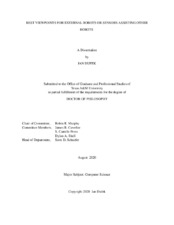| dc.contributor.advisor | Murphy, Robin R | |
| dc.creator | Dufek, Jan | |
| dc.date.accessioned | 2021-02-02T16:50:45Z | |
| dc.date.available | 2021-02-02T16:50:45Z | |
| dc.date.created | 2020-08 | |
| dc.date.issued | 2020-07-14 | |
| dc.date.submitted | August 2020 | |
| dc.identifier.uri | https://hdl.handle.net/1969.1/192260 | |
| dc.description.abstract | This dissertation creates a model of the value of different external viewpoints of a robot performing tasks. The current state of the practice is to use a teleoperated assistant robot to provide a view of a task being performed by a primary robot. However, there is no existing model of the value of different external viewpoints and the choice of viewpoints is ad hoc not always leading to improved performance. This research develops the model using a psychomotor approach based on the cognitive science concept of Gibsonian affordances. The two central tenets of the approach are that the value of a viewpoint depends on the affordances for each action in a task and that viewpoints in the space surrounding the action can be rated and adjacent viewpoints with similar ratings can be clustered into manifolds of viewpoints with the equivalent value. In this approach, viewpoints for the affordances are rated based on the psychomotor behavior of human operators and clustered into manifolds of viewpoints with the equivalent value. The value of 30 viewpoints is quantified in a study with 31 expert robot operators for 4 affordances (Reachability, Passability, Manipulability, and Traversability) using a computer-based simulator of two robots (PackBot and TALON). The adjacent viewpoints with similar values are clustered into ranked manifolds using agglomerative hierarchical clustering with average linkages. The results support the two central tenets showing the validity of the affordance-based approach by confirming that there are manifolds of statistically significantly different viewpoint values, viewpoint values are statistically significantly dependent on the affordances, and viewpoint values are independent of a robot. Furthermore, the best manifold for each affordance provides a statistically significant improvement with a large Cohen's d effect size (1.1-2.3) in performance (improving time by 14%-59% and reducing errors by 87%-100%) and improvement in performance variation over the worst manifold. This model creates the fundamental, principled understanding of external viewpoints utility based on psychomotor behavior and contributes ranked manifolds of viewpoints for four common affordances. This model will enable autonomous selection of the best possible viewpoint and path planning for the assistant robot. | en |
| dc.format.mimetype | application/pdf | |
| dc.language.iso | en | |
| dc.subject | Human-Robot Interaction | en |
| dc.subject | Telerobotics | en |
| dc.subject | Multi-Robot Systems | en |
| dc.title | Best Viewpoints for External Robots or Sensors Assisting Other Robots | en |
| dc.type | Thesis | en |
| thesis.degree.department | Computer Science and Engineering | en |
| thesis.degree.discipline | Computer Science | en |
| thesis.degree.grantor | Texas A&M University | en |
| thesis.degree.name | Doctor of Philosophy | en |
| thesis.degree.level | Doctoral | en |
| dc.contributor.committeeMember | Caverlee, James B | |
| dc.contributor.committeeMember | Peres, Camille S | |
| dc.contributor.committeeMember | Shell, Dylan A | |
| dc.type.material | text | en |
| dc.date.updated | 2021-02-02T16:50:46Z | |
| local.etdauthor.orcid | 0000-0003-4934-3242 | |


